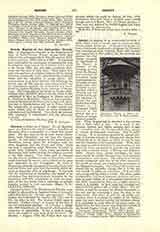

Canopus, a titular see of Egypt. Its old Egyptian name was Pekuat; the Greeks called it Kanobos, or Kanopos, after a commander of a Greek fleet buried there. The city stood in the seventh Nomos (Menelaites, later Canopites), not far from the Canopic mouth. It had many martyrs in the persecution of Diocletian, among others St. Athanasia with her three daughters, and Sts. Cyrus and John. There was here a monastery called Metanoia, founded by monks from Tabennisi, where many patriarchs of Alexandria took shelter during the religious quarrels of the fifth century. Two miles east of Canopus was the famous heathen temple of Manouthin, afterwards destroyed by monks, and a church on the same spot dedicated to the Evangelists. St. Cyril of Alexandria solemnly transported the relics of the holy martyrs Cyrus and John into the church, which became an important place of pilgrimage. It was here that St. Sophronius of Jerusalem was healed of an ophthahny that had been declared incurable by the physicians (610-619), whereupon he wrote the panegyric of the two saints with a collection of seventy miracles worked in their sanctuary (Migne, P.G., LXXXVII, 3379-676).
Canopus formed, with Menelaus and Schedia, a see subject to Alexandria in Aegyptus Prima; it is usually called Schedia in the “Notitim episcopatuum”. Two titulars are mentioned by Lequien (II, 415), one in 325, the other in 362. The modern Arabic name is
Aboukir, “Father Cyrus”, in honor of the first of the two celebrated martyrs. It is today a village with 1000 inhabitants, at the end of a little peninsula northeast of Alexandria. It has a trade in quails, which are caught in nets hung along the shore. Off Aboukir, August 1, 1798, the French fleet was destroyed within the roads by Nelson; July 25, 1799, Bonaparte destroyed there a Turkish army 18,000 strong; and on March 8, 1801, the French garrison of 1800 men was defeated by. 20,000 English and Turks commanded by Abercromby.
S.VAILHE

